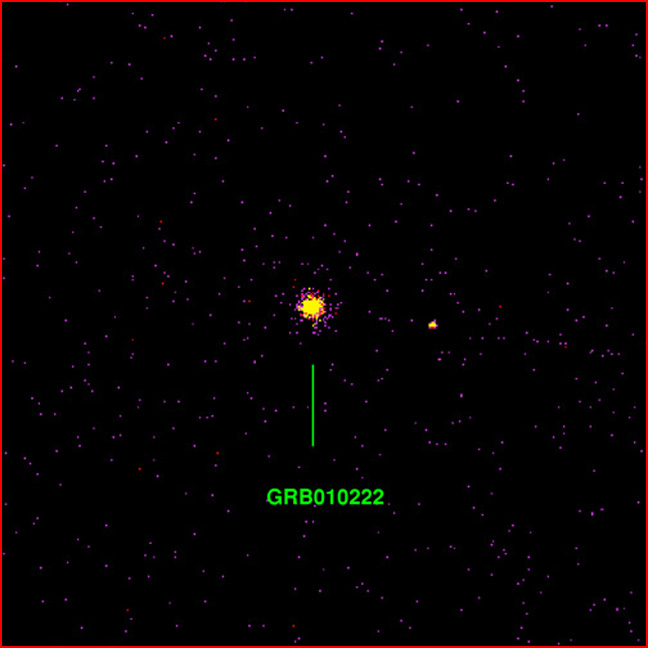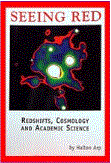|
|
||
 Credit: L. Piro (CNR) et al., CXC, NASA |
||
|
pic of the day Links:
Society for
Redshifts, Cosmology and Academic Science Order Link $25.00 |
Aug 20, 2004 The estimated size of a gamma ray burst depends on its distance. Redshift=distance makes some if not all gamma ray bursts impossibly energetic. A fading afterglow from a gamma ray burst is centered in this false color image from the space-based Chandra X-ray Observatory. While the gamma rays are produced for only a few seconds, many of these events can be identified by their afterglow in X-ray, visible light and radio waves. These are often associated with galaxies at great distances. Astronomers describe them as the biggest explosions in the universe. But the estimated size of a gamma ray burst depends on its distance. If we think it is far away, the burst will seem much larger than if we think it is nearby. So when we start seeing "the biggest explosions in the universe" it behooves us to take another look at how we determine their distance. Almost all of the millions of galaxies are redshifted (there are less than a dozen known exceptions to this rule.) This means that when we look at the spectra (rainbows) made of their light, the lines which identify particular elements are shifted toward the red (longer wavelengths). In the late 1920's, a few years after astronomers finally realized that galaxies were outside of the Milky Way, Edwin Hubble (after whom the Hubble telescope was named) noticed that there is a relationship between how big and bright a galaxy is and how much its light is redshifted. For the hundreds of galaxies he studied, the big, bright galaxies had low redshifts and the small faint galaxies had high redshifts. Adding the assumption that big and bright means closer than small and faint, astronomers concluded that redshift could be used as a measure of distance. Most (but not all) astronomers also assumed that this galactic redshift is a measure of velocity (just as a train whistle sounds lower when it's going away than when it's approaching, light can become redshifted when the object is going away and blueshifted when it is approaching.) All of the expanding universe and big bang theories are based on this assumption, neatly summed up in the description, "the farther away a galaxy is, the faster it is moving away." But does it work? In the 1960's, Halton Arp began documenting cases where redshift couldn't possibly mean distance. He was finding instances where two or more galaxies and/or quasars were associated, or even physically connected, in contradiction of the assumption that their different redshifts meant that one should be millions or even billions of light-years farther away than the other. He concluded that using redshift as a measure of distance distorts the actual distance. The higher the redshift, the greater the distortion. So what does that mean for the gamma ray bursts? Many of the first gamma ray bursts identified by their afterglow in the late 1990's were from galaxies with very high redshift, indicating distances as far as 12 billion light years. The energy required to produce the observed flash of gamma-rays from this distance would be staggering! Nothing observed in our stellar neighborhood comes close, not even the occasional supernova. So the question becomes, are the gamma ray bursts an unknown form of hypernova? Or are the redshift distances to their host galaxies greatly exaggerated, and the explosions much smaller? New light was shed on this question by a gamma ray burst on December 3rd, 2003 (GRB 031203). This burst was identified with a closer galaxy, only about 1.3 billion light years away (by the redshift assumption.) This burst was thoroughly studied for months by an armada of space and ground-based observatories. Astronomers concluded that this was the closest cosmic gamma-ray burst on record, but also the faintest. This led the researchers to ask whether gamma ray bursts come in a variety of sizes. The other possibility is that the variation of intensity between distant and nearby gamma ray bursts is one more layer of evidence that redshift is not an accurate measure of distance. The high-redshift gamma ray burst and the low-redshift gamma ray burst may have been of similar intensity, but astronomer's assumption that one is much farther away has made it appear much brighter. Since gamma ray bursts are common events (about one a day is detected, although only a few are identified with host galaxies), perhaps they will become the crucial observation that brings the redshift/distance distortion into better focus. If that happens, we will find ourselves living in a completely new universe that didn't begin in a big bang and isn't expanding. And in this new universe, galaxies give birth to quasars, which grow up into new galaxies. The gamma ray bursts may be the electromagnetic cry of a newborn galaxy. [See Arp's lecture video, "Intrinsic Redshift," for more details of this new picture of the universe.] Available from Mikamar Publishing |
|
|
Copyright 2004: thunderbolts.info |
||

